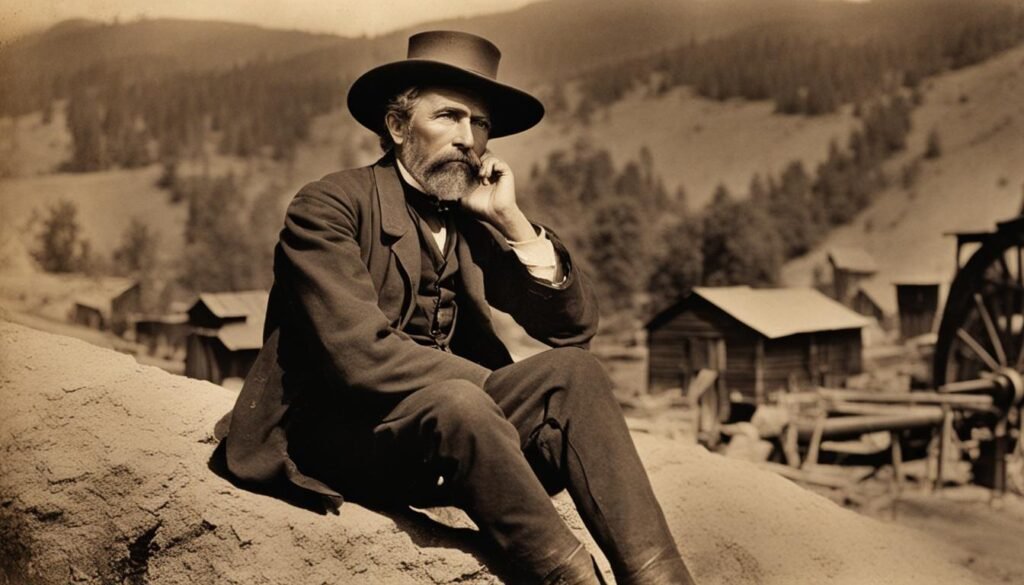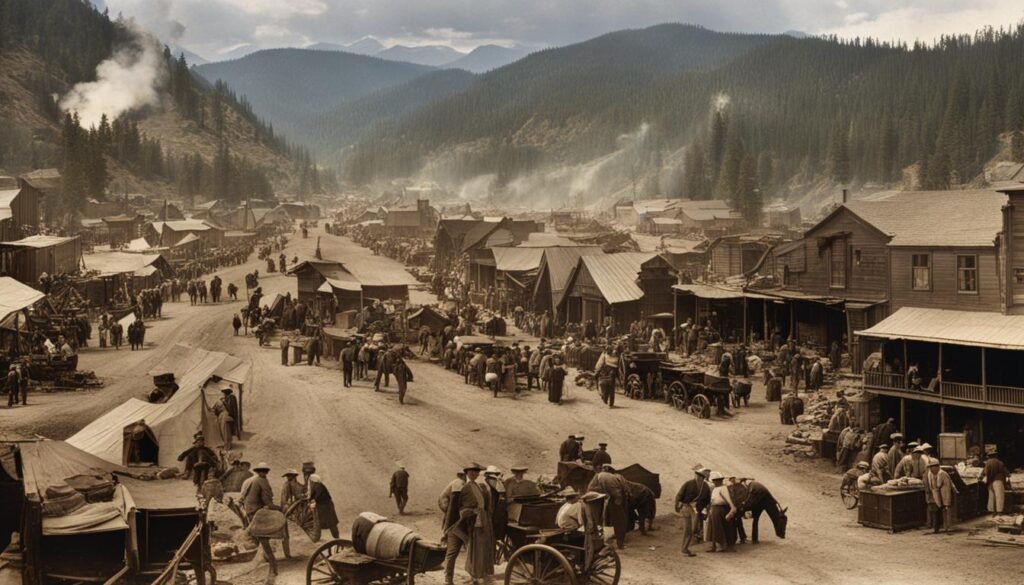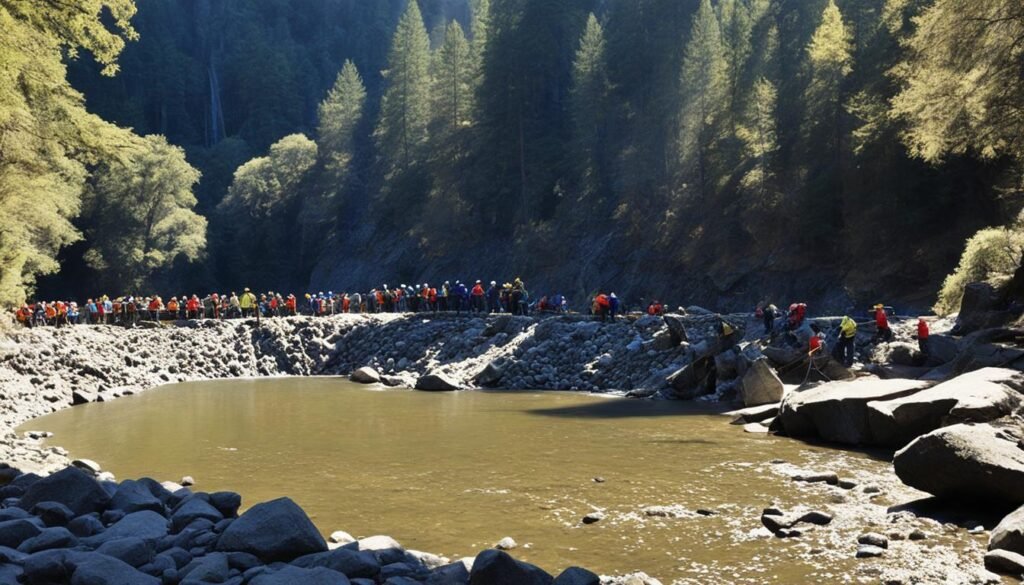When it comes to the California Gold Rush, one name stands out: John Sutter. This German-born Swiss pioneer settler played a pivotal role in the events that unfolded in 1848, forever changing the destiny of California. It was on Sutter’s land, specifically at Sutter’s Mill, where gold was discovered, igniting an unprecedented frenzy for fortune and transforming the entire region.
Key Takeaways
- John Sutter played a significant role in the California Gold Rush.
- Gold was discovered at Sutter’s Mill in 1848, leading to a massive influx of fortune seekers.
- Sutter’s Mill became the epicenter of the Gold Rush, attracting people from all over the world in search of gold.
- The discovery reshaped California’s destiny and had a lasting impact on its history and development.
- The Gold Rush brought both opportunity and hardship, leaving a lasting legacy in California’s cultural identity.
The Life of John Sutter
John Sutter, originally named Johann August Suter, was a prominent figure in the history of California. Born on February 15, 1803, in Kandern, Baden, Germany, Sutter later became a Swiss citizen and served in the Swiss army. In 1839, he embarked on a journey to California and established the colony of Nueva Helvetia, known as New Switzerland, on the Sacramento River.
To establish his presence in the region, Sutter constructed Sutter’s Fort, which became a vital trading post attracting traders, trappers, and immigrants. The fort provided a safe haven and essential resources for those venturing into the untamed frontier.

Despite his initial success, John Sutter’s life took a dramatic turn with the discovery of gold on his land. The news of gold at Sutter’s Mill in 1848 attracted fortune seekers from all over the world, leading to the California Gold Rush. Unfortunately for Sutter, instead of profiting from the gold rush, he faced financial ruin.
In the wake of the gold discovery, his land was overrun by prospectors, causing significant damage and disruption to his operations. Sutter’s property rights were constantly challenged, and legal battles further drained his resources. By 1852, Sutter was forced into bankruptcy, and his dream of establishing a prosperous agricultural empire came crashing down.
The life of John Sutter serves as a testament to the unpredictable nature of history. Despite his ambitions and achievements, his name remains forever associated with the gold rush that ultimately brought about his downfall.
The Discovery of Gold at Sutter’s Mill
In January 1848, a carpenter named James W. Marshall made an astonishing discovery that would change the course of history. While working on the construction of a sawmill at Sutter’s Mill in Coloma, California, Marshall stumbled upon a significant deposit of gold. This gold discovery at Sutter’s Mill marked the beginning of one of the most influential events in American history – the California Gold Rush.
Initially, Marshall and John A. Sutter, the owner of the mill and the surrounding land, tried to keep the discovery a secret. However, their efforts were in vain as the news quickly spread like wildfire. Soon, thousands of fortune seekers from all walks of life descended upon Sutter’s land in search of riches and prosperity.
The allure of the gold discovery at Sutter’s Mill was irresistible, drawing individuals from across the United States and around the world. People abandoned their homes, families, and jobs to join the gold rush frenzy. Towns and cities sprang up almost overnight, and the population of California skyrocketed.
However, the discovery of gold at Sutter’s Mill also brought significant challenges and consequences. The influx of people seeking their fortunes brought about various social, environmental, and economic changes. Sutter’s Fort, once an important trading post, became overrun with gold prospectors and lost its former significance.
- This image depicts the Sutter’s Mill where gold was discovered, igniting the California Gold Rush. The sawmill holds historical importance and represents a pivotal moment in American history.
The discovery of gold at Sutter’s Mill forever altered the landscape and identity of California. It accelerated its growth, established San Francisco as a leading city, and shaped the state’s economy. The Gold Rush also had a profound impact on the indigenous people of the region, leading to displacement and conflict.
In conclusion, the discovery of gold at Sutter’s Mill by James W. Marshall triggered the California Gold Rush, a pivotal event that attracted thousands of fortune seekers and reshaped the destiny of California. The allure of gold transformed the region and left a lasting legacy in the form of iconic landmarks, cultural heritage, and a rich history that continues to captivate and inspire.
The Impact of the Gold Rush
The California Gold Rush had a transformative impact on the region. The discovery of gold in California sparked a frenzy of activity and attracted people from around the world in search of fortune. What started as a gold fever quickly turned into one of the largest mass migrations in history.
The influx of gold seekers, known as “forty-niners” due to the year the rush began, led to rapid population growth and the development of boom towns. Cities like Sacramento and San Francisco grew exponentially as pioneers flocked to the region in search of wealth.
However, the Gold Rush also had negative consequences. The rapid population growth resulted in the displacement of Native Americans, as their lands were taken over by prospectors. Environmental damage was another significant impact of the Gold Rush, as mining activities had a profound effect on the landscape.
Additionally, the social fabric of California underwent significant upheaval during this period. The diverse population of pioneers from different backgrounds and cultures created a melting pot of ideas and perspectives, shaping the future of the state.
Development of Industries
While gold mining was the primary industry during the Gold Rush, it also sparked the development of various supporting industries. Businesses emerged to cater to the needs of the miners, supplying tools, equipment, and provisions. Saloons, general stores, and hotels flourished in the boom towns that sprang up along the Sacramento River.
The expanding population also created a demand for infrastructure. Roads, bridges, and railroads were built to facilitate transportation and connect mining areas with urban centers. The increased economic activity brought prosperity to many, including merchants, entrepreneurs, and landowners.

Lasting Impact on California
The Gold Rush shaped the future of California in numerous ways. It served as a catalyst for the rapid growth and development of the state, laying the foundation for its future prosperity. The influx of wealth and people transformed California from a remote outpost to a booming economy.
Although gold mining declined after the initial rush, California continued to attract settlers and experienced significant population growth. The diverse population and entrepreneurial spirit established during this time are still evident today, making California a vibrant and culturally rich state.
The legacy of the Gold Rush can be seen in the numerous historic parks, landmarks, and museums dedicated to preserving its history. These sites serve as a reminder of the monumental impact that gold discovery had on the landscape, economy, and people of California.
The Legacy of the Gold Rush
The Gold Rush in California left a lasting legacy that can still be witnessed today. While not all miners struck it rich, the pursuit of gold had a profound impact on the state’s development. It led to the growth of cities like San Francisco and the creation of industries that supported mining activities.
Although gold mining declined after the 1850s, California continued to attract settlers seeking new opportunities. The population of the state experienced significant growth as a result. Today, visitors can explore the rich history of the gold rush through preserved historic parks and landmarks.
The legacy of the gold rush history is deeply rooted in the culture and identity of California. It shaped the foundation of communities and industries that continue to thrive to this day.
Explore the remnants of this historic era by visiting landmarks in Sutter County, where the gold discovery at Sutter’s Mill ignited the California Gold Rush. Marvel at the incredible stories and artifacts that tell the tale of this transformative period in American history.
Conclusion
The John Sutter Gold Rush and the subsequent California Gold Rush of 1848 had a profound impact on California’s history and development. The discovery of gold at Sutter’s Mill brought a massive influx of people seeking their fortunes, reshaping the destiny of the region. The Gold Rush became a pivotal moment that propelled California into a booming economy and cultural hub.
The gold discovery at Sutter’s Mill was the catalyst that ignited the feverish pursuit of wealth. People from all walks of life flocked to California, hoping to strike it rich and build a better future. Sutter’s Fort, originally established by John Sutter as a trading post, became a central hub for gold prospectors and a symbol of the Gold Rush’s impact on the region.
While the Gold Rush brought immense opportunity and wealth to some, it also had its darker side. The pursuit of gold led to environmental damage, displacement of Native American populations, and social unrest. Yet, the lasting legacy of the Gold Rush remains evident today in California’s rich history, cultural diversity, and enduring spirit of innovation.
FAQ
What role did John Sutter play in the California Gold Rush?
John Sutter, a Swiss pioneer settler, played a significant role in the California Gold Rush. His land at Sutter’s Mill was where gold was discovered in 1848, leading to a massive influx of fortune seekers to the area.
When was gold discovered at Sutter’s Mill?
Gold was discovered at Sutter’s Mill in January 1848.
What happened at Sutter’s Mill?
Sutter’s Mill is where gold was discovered in California, sparking the California Gold Rush in 1848.
Who found gold at Sutter’s Mill?
Gold was found by a carpenter named James W. Marshall while working on a sawmill at Sutter’s Mill.
What impact did the Gold Rush have?
The Gold Rush had a transformative impact on California, leading to rapid population growth, the development of boom towns, and the displacement of Native Americans. It also sparked the growth of various industries and had a lasting impact on California’s economy.
What is the legacy of the Gold Rush?
The Gold Rush left a lasting legacy in California, with the growth of cities like San Francisco and the development of industries supporting mining activities. California’s gold rush history is preserved in historic parks and landmarks.







